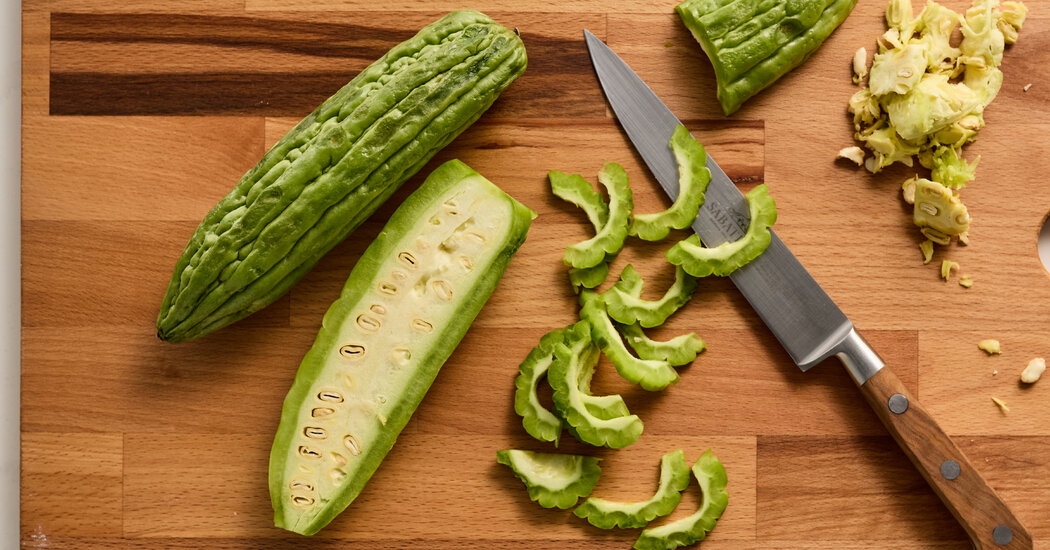On broad banana leaves, dishes of sweet soy dipping sauce, a creamy pork liver sauce, a bubbling pinakbet, some sticky rice and a raw salad of slivered bitter melon and red onion flank a crackling lechon like planets orbiting the sun. This is the final savory course of the kamayan dinner, a Filipino family-style meal, at Naks in the East Village of Manhattan. Small but mighty, raw and crisp, the vibrantly green bitter melon packs a fierce bitterness that effortlessly holds up against the other heady accouterments.
“It adds a little complexity,” said Eric Valdez, the chef at Naks. “It plays around with your senses, in a good way.”
As a child in Manila, Mr. Valdez didn’t care for bitter melon, an oblong summer squash, also known as bitter gourd, with a wrinkly, ridged surface and spongy seed pocket. But his mother, believing it was nutritious, kept serving it to the family. She’d envelop the bitter melon in rich scrambled eggs and sweet shrimp in a stir-fry that tempered its bitterness.
It wasn’t until Mr. Valdez became a chef in New York City that he began to appreciate that bitterness for what it is. It cuts through the fattiness of lechon, for instance. But he acknowledges that bitter melon is a challenging ingredient for many diners, even if they, too, grew up eating it.
“The only way I’m getting away with it is because it’s on a tasting menu,” Mr. Valdez said, laughing. “If I put it on a regular à la carte menu, it’s kind of scary.”
Bitter melon is a traditional ingredient in cuisines across Asia, as well as parts of Africa and Latin America, and often valued for its numerous health benefits. While it isn’t easy to find it on menus in the United States, some Asian American chefs are embracing the hard-to-love ingredient anew and putting bitter melon on display — loud, proud and boldly bitter.
Bitter melon balances the flavors of the goong chae nam pla, a spicy raw shrimp salad, that Chutatip Suntaranon serves at Kalaya, her Thai restaurant in Philadelphia. Ms. Suntaranon, who is known as Nok, makes it the same way her mother did in the southern Thai city of Trang, piling bitter melon and prawn slices on a bed of cabbage, then drenching it in fish sauce, garlic, lime juice and chiles.
Whenever the shock of bitterness is met with resistance from diners, she explains how the bitterness complements the spiciness. “Coffee, chocolate, even the Maillard reaction — part of it is the bitterness hidden in it that creates a harmony of flavors,” Ms. Suntaranon said.
In China, there’s an adage that one must “eat bitter” — struggle, even suffer — before reaping sweet rewards. This mentality applies quite literally to bitter melon. Stomach its bitter sting, the thinking goes, and you’ll be treated to a vitamin-dense, fiber-rich food that some studies have suggested may lower cholesterol and blood glucose in Type 2 diabetes patients.
“It’s pretty powerful,” said Dr. Linda Shiue, who practices internal and culinary medicine at Kaiser Permanente Medical Center in San Francisco and is the author of the cookbook “Spicebox Kitchen.” “Blood sugar, cholesterol — these are all things that affect so many people.”
Yet people around the world have been eating bitter melon for these and more health benefits for centuries, without the need for proof from recent studies in Western medicine. “All the aunties will say, ‘Hey, I told you so,’” Dr. Shiue said.
Jon Yao, the chef of the Taiwanese American tasting-menu restaurant Kato in Los Angeles, tried to incorporate bitter melon into the restaurant’s courses. He sliced it thinly and shingled it on a piece of fish as a garnish, for example, but this and other attempts didn’t pass the “staff test.”
“I think most people’s reaction was, ‘Wow, it’s too bitter, it kind of dominates,’” he said.
The gourd eventually found its way through Kato’s doors. Last year, the bar director, Austin Hennessy, created a mocktail that blends bitter melon and cucumber juice. The drink recalls bitter-melon juice stands found throughout Taiwan, where the vegetable’s juice is pressed fresh to order for bracingly bitter shots.
Those stands often employ a white Okinawan variety of bitter melon. Leslie Wiser has been growing this and a handful of other bitter-melon varieties at Radical Family Farms, her three-acre farm in Sebastopol, Calif., since 2019. a way of connecting with her Taiwanese heritage. She has been eating bitter melon regularly since 2020, when she learned she had high cholesterol.
Ms. Wiser said many of her customers at the city’s farmers’ market seek out bitter melon for its health benefits, too. She is making sure that her children grow up accustomed to bitter melon. “It’s kind of a universal experience, not liking it and then finding appreciation as adults,” she said.
Farmers in the United States also grow karela, the spiky, smaller Indian variety of bitter melon. Nimai Pandit cultivates it at the 120-acre Hudson Valley, N.Y., location of Gopal Farm, which specializes in Indian vegetables and herbs, and used to bring it to the Union Square Greenmarket. People from various backgrounds would come to his stand delighted to find the gourd.
“There is a lot of culture around eating bitter gourd,” Mr. Pandit said. According to Ayurvedic medicine, bitter melon should be eaten at the beginning of a meal to help you digest it. Understanding that food is medicine is important to appreciating it, he said.
One of the first chef customers of Gopal Farms’ stand was Dan Barber of Blue Hill at Stone Barns. “He couldn’t do anything with it,” Mr. Pandit said of the gourd. “He said it was too bitter.”
But Mr. Pandit has found another way to persuade customers to give it a chance.
“I would say, ‘Don’t have this, it’s too bitter,’ ” he said. So then, they would definitely want to have it. Especially if they’re young.”







